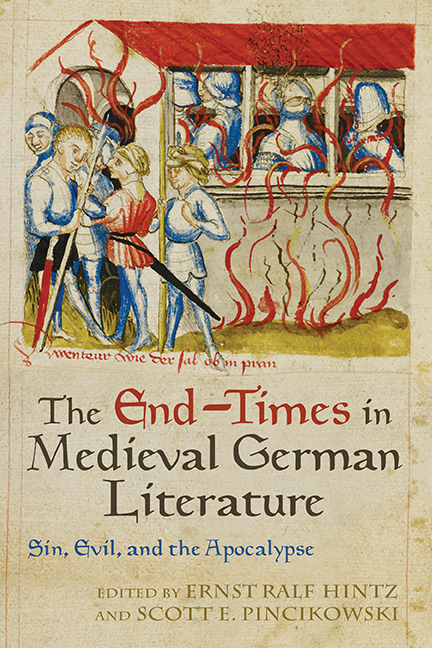Book contents
- Frontmatter
- Dedication
- Contents
- Acknowledgments
- Introduction
- 1 Thiu wirsa giburd: Cain’s Legacy, Original Sin, and the End of the World in the Old Saxon Genesis
- 2 The Heliand Revisited: Spiritual Transgendering and the Defiance of Evil
- 3 The Beginning of the End: Binary Dynamics and Initiative in Hartmann von Aue’s Gregorius
- 4 Poetic Reflections in Medieval German Literature on Tragic Conflicts, Massive Death, and Armageddon
- 5 Beyond Good and Evil: Apocalyptic Vision without Judgment in the Nibelungenlied. An Essay
- 6 End-Times in the Hall: The Modern Reception of the Apocalyptic Ending of the Nibelungenlied
- 7 Past Present, Future Present? Visualizing Arthurian Romance and the Beholder’s Share in a World That Refuses to End
- 8 Ich diene und wirbe / biz ich gar verdirbe: Lovesickness, Apocalypse, and the End-Times in Mauritius von Craûn and Das Nibelungenlied
- 9 The Slippery Concept of Evil in Hartmann von Aue’s Erec and Iwein
- 10 Wigamur’s Lessons on the Complexity of Evil
- 11 The Miracles of the Antichrist
- 12 Monsters and Monstrosities in the Pamphlet Wars of the Reformation
- Notes on the Contributors
- Index
2 - The Heliand Revisited: Spiritual Transgendering and the Defiance of Evil
Published online by Cambridge University Press: 21 March 2020
- Frontmatter
- Dedication
- Contents
- Acknowledgments
- Introduction
- 1 Thiu wirsa giburd: Cain’s Legacy, Original Sin, and the End of the World in the Old Saxon Genesis
- 2 The Heliand Revisited: Spiritual Transgendering and the Defiance of Evil
- 3 The Beginning of the End: Binary Dynamics and Initiative in Hartmann von Aue’s Gregorius
- 4 Poetic Reflections in Medieval German Literature on Tragic Conflicts, Massive Death, and Armageddon
- 5 Beyond Good and Evil: Apocalyptic Vision without Judgment in the Nibelungenlied. An Essay
- 6 End-Times in the Hall: The Modern Reception of the Apocalyptic Ending of the Nibelungenlied
- 7 Past Present, Future Present? Visualizing Arthurian Romance and the Beholder’s Share in a World That Refuses to End
- 8 Ich diene und wirbe / biz ich gar verdirbe: Lovesickness, Apocalypse, and the End-Times in Mauritius von Craûn and Das Nibelungenlied
- 9 The Slippery Concept of Evil in Hartmann von Aue’s Erec and Iwein
- 10 Wigamur’s Lessons on the Complexity of Evil
- 11 The Miracles of the Antichrist
- 12 Monsters and Monstrosities in the Pamphlet Wars of the Reformation
- Notes on the Contributors
- Index
Summary
THe IMAGE OF VOLKER calmly, defiantly fiddling before the hall in the Nibelungenlied, or Davy Crockett during the 1836 siege of the Alamo playing his fiddle within earshot of Santa Anna's army—these are images that remain in our memory. They also lend themselves well to adaptation, whether by Fritz Lang in his 1924 film Die Nibelungen or the last version to date in a long line of Alamo films from 1911 to 2004. During school vacations as a boy, I often ventured into the world of James Fenimore Cooper and the Leatherstocking Tales. Natty Bumppo, aka Hawkeye, and Chingachgook, his Native American companion, embody the heroic ethos of the frontier. In the 1992 film adaptation, Hawkeye is captured and then is released on his word—his honor—and vows to return the next day. After he fulfills his promise to his captors, they bind him for execution. His return is not merely an irrational, impulsive act of heroic bravado. While an enemy warrior hurls one tomahawk after another, Hawkeye mocks his aim and laughs in defiance of death. This form of defiance is the first of three narrative components that, when taken together, contribute to a balanced understanding of the Heliand. As Harald Haferland observes in his Heliand study, “The Hatred of Enemies” (2010), resistance in the face of death and insurmountable odds is germane to heroic epic behavior and, as such, is an inherent quality also suited to the Heliand: “The struggle of Jesus’ enemies against him and, in turn, his resistance against them, constitute the center of the poet's understanding of Jesus’ acts and suffering.” Yet, as a biblical heroic epic with religious educational intent, the rationale of heroic defiance differs from the posturing, pride, and sense of honor in conventional heroic epics such as The Battle of Maldon or Das alte Atlilied by the very nature of Christ. As such, the Saxon monastic author adapts the Gospel narrative in portraying the Heliand as a warrior sent from a divine realm on a salvific mission. Its chief objective is to “heal”—that is, convert the Saxon nobility away from a deep-rooted belief in a spiritually pernicious warrior code that extols the defiance of death for fame and admiration, the traditional hatred of enemies, and associated retribution, to a radically new warrior ethos.
- Type
- Chapter
- Information
- The End-Times in Medieval German LiteratureSin, Evil, and the Apocalypse, pp. 27 - 49Publisher: Boydell & BrewerPrint publication year: 2019



